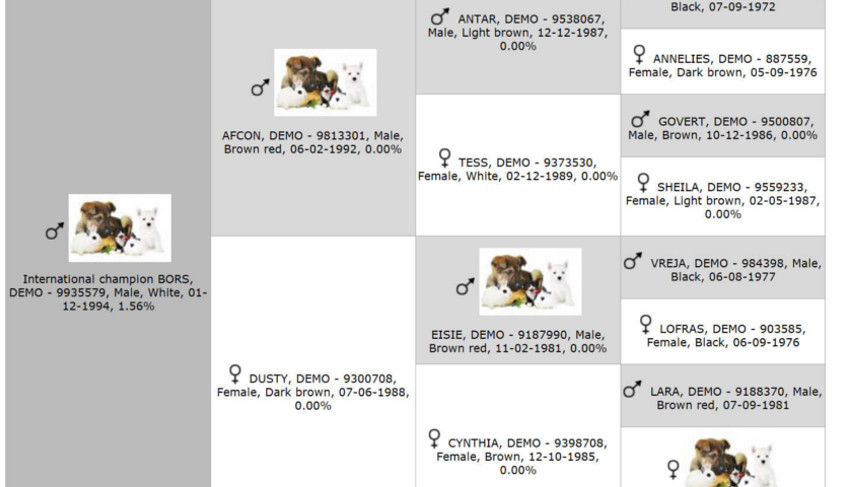
Before you start breeding, you want to know how the animals are related to each other. But what is the difference between inbreeding, relationship percentage and AVK? And what does inbred mean? And how to define inbreeding?
AVK is the German acronym for AhnenVerlust-Koeffizient, which means “ancestor loss coefficient”. The purpose is to measure how many ancestors occur multiple times in a family tree of five generations. If every ancestor is unique, the AVK is 100%. But if there has been line breeding in the past, then the value is lower. When all five generations are complete, there are 62 animals in the pedigree. Suppose that two animals occur twice in the pedigree, then 62 – 2 = 60 unique animals remain. The calculation is 60 divided by 62, multiplied by 100. So, in this case the AVK is 96.77%.
An AVK of less than 100% is always an indication that there has been inbreeding in the pedigree of an animal, but you cannot tell if it is this animal or one or more of its ancestors that has been inbred. The AVK of an animal is therefore not necessarily related to the inbreeding coefficient of the animal, but could relate to its ancestors.
Where can you find the AVK?
The AVK is listed with the basic data of each animal.
Tip
Click on the family tree. Animals with a yellow, blue and green ball next to the name appear several times on the pedigree and provide a lower AVK.
The relationship percentage indicates the extent to which two animals are genetically similar. When two animals breed, they each pass 50% of their genes to the young animal. The animal is thus 50% related to the father and 50% to the mother. These genes are passed on from generation to generation. The relationship coefficient is calculated by ZooEasy on the basis of the pedigree. The percentages below apply if the parents are not related to each other. If this is the case, the percentages are higher:
With a double nephew or niece, the fathers are full brothers, and the mothers are full sisters. With a single cousin or niece, two of the four parents are full brothers or sisters.
How do you calculate the relationship between animals?
Tip
Go to the basic data of your animal. On the Blood Relations tab you can easily find all family members of the animal, such as half-brothers and sisters, grandchildren, cousins, etc.
Inbreeding occurs when two related animals (see relationship percentage) are bred. In other words, if the father and the mother are related, then the offspring is cultivated. Mammals and birds have two DNA strands, so a gene comes from each pair. Human DNA consists of about 40,000 gene pairs. For each gene pair, one gene comes from the father and the other from the mother. The inbreeding coefficient is the probability that both parents will pass exactly the same gene to their offspring. For example, the inbreeding coefficient of inbreeding dogs therefore calculates the probability that a dog will actually receive two genes that are exactly the same from both parents.
What does inbred mean?
How do you calculate the inbreeding percentage?
The inbreeding percentage is stated in the basic data for each animal.
The reliability of the figures in your database depends on the data entry. If you do not enter the parents of an animal, you will always receive an inbreeding coefficient of 0 and an AVK of 100%. But that does not mean that the animal has not been inbred. This is why, the more complete generations of animals you enter, the more reliable your figures will be.
The information above is provided by Dr. P. Bijma of the Breeding and Genetics Chair Group at Wageningen University & Research, and processed by ZooEasy using the calculation methodology of inbreeding, relationship percentage and AVK.